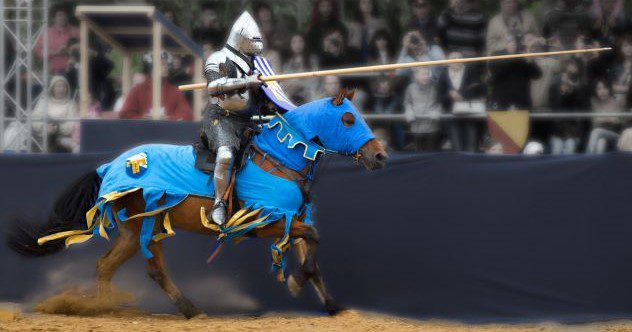10 Exciting Facts About The Field Of The Cloth Of Gold


History may give the impression that they were inclined to do the opposite, but Europe's medieval and Renaissance kings sometimes spent a lot of time and money on securing peace – or gave the impression that that was what they were doing. The fortnight-long festival of the “Field of the Cloth of Gold” in 1520 is an example of this.
The event saw old enemies England and France gather for two weeks of friendly tournaments and feasts to cement the nations' new friendship. However, it is believed that both the kings had some ulterior motives, making it one of the most extraordinary diplomatic exercises ever. Here are ten facts about the fascinating time when Kings Francis I and Henry VIII gathered together for what became one of the most famous festivals of all time.
Connected: Top 10 Royals Who Were Absolutely Crazy
10 It was really about the ego of the young kings
It will come as no surprise to learn that the two kings who essentially thought they could party to peace were both under the age of 30. Francis I of France was 25 years old at the time of the Field of Gold, while Henry VIII of England was three years old. years old. However, a meeting between the two was actually stipulated in the Treaty of London, a peace treaty agreed to by the major European powers of the time.
The meeting was officially meant to cement the friendship of the young kings and celebrate the end of nearly two centuries of war between the two countries. Yet, while it was peaceful, it did nothing to stop the two young kings from outdoing each other.
Each man wanted to make a statement for the history books about how they saw themselves and their country, which meant excessive displays of wealth, power, and sophistication. The result of his efforts to show off was unlike any extraordinary display seen before.(1)
9 thousands of people participated
There is no such place as the “Field of the Cloth of Gold”. The actual location of the incident was the Pale of Calais, a valley between the cities of Guines and Ardres in what is today the north of France, but at the time, it was ruled by the British. So, how did the meeting get its name? In a spirit of showcasing his power and wealth, each king brought with him about 6,000 people.
These huge parties obviously needed places to stay, so tents and pavilions were built. Many of these were made from fine and luxurious fabrics such as cloth of gold. It is because of this grand residence that this event got its name. Although many of the guests were aristocrats, not only were their accommodations luxurious but so was their clothing. Some of Henry VIII's party arrived wearing gold coats, which were at first mistaken for armor and caused panic among the French for a while.(2)
8 Kings lead teams in arms competition
Part of the political process of achieving peace in the Renaissance was to demonstrate readiness for war. This could be done through military competitions and tournaments, which were the main events in the field of cloth of gold. About 300 people from each side, including the two kings, competed over two weeks in one of three competitions available. These were horseback riding, a type of team fighting on horseback called a “tourney”, and fighting on foot, separated from opponents by a barrier.
Both Henry and Francis earned praise for their expulsion, although to avoid disagreement they competed for volunteers rather than against each other. However, the competitions were canceled for several days due to bad weather, so Henry, Francis, and their men began looking for other methods of entertainment that were less dependent on the weather. This was the only time during this incident that they had physical relations with each other.(3)
7 kings wrestled each other
Although he often appears portly in paintings, Henry VIII was reportedly an accomplished athlete in his younger days. In the 16th century, this mostly meant being good at archery and horsemanship, but Henry had another passion – wrestling. This was a passion shared by his French counterpart. In fact, for Francis it was not only a passion but part of his identity. In addition to being King of France, he was Duke of Brittany, a region renowned throughout the country for the skill of its wrestlers.
With some outdoor activities at the Field of the Gold Cloth cancelled, the French began challenging the English to wrestling matches. It proved so popular that even priests joined in. Eventually, the enthusiastic Henry could not help but grab Francis by the collar and challenge him to a match. Henry, however, proved to be by no means a match for Francis, whose finisher was a move called the “Tour de Bretagne”. English historians were surprisingly hesitant to record King Henry's humility. However, he regained some dignity by outrunning Francis with his long bow.(4)
6 Henry VIII had a “portable palace” with a wine fountain
The sleepwear arena attendees had never heard of the portmanteau “glamping,” but they certainly knew how to do it in style. However, the sumptuous pavilions of the soldiers paled in comparison to Henry's residence, who had a huge portable palace built to hold banquets and parties. It had an area of about 328 square feet (30.5 m) and was about 40 feet long (12.2 m), with four blocks of rooms around a central courtyard.
Designed to look like London's Hampton Court Palace, it was built mostly of wood, covered in a canvas that resembled real stone, and because of its stained-glass windows the French called it the Crystal Palace. Given a nickname. And if the stained glass windows weren't enough to impress the other party, Henry also installed a nearly endless wine fountain where his guests could help themselves to drinks.(5)
5 Feasts included up to 50 dishes and even the statues were edible
While Henry had his own portable palace, the centerpiece of the French camp was a stunning 120-foot (36.6-meter) long sleeping tent. It was quickly removed when the weather changed, so it never hosted any feasts. However, a less spectacular location wasn't disappointing anyone. The 12,000 attendees received 29,000 fish, 98,000 eggs, over 6,000 birds, 2,200 sheep, and an incredible 216,000 gallons of wine.
There have been no accidents at the archery range, which is truly amazing. Most of the supplies came from traders from nearby towns, although the English camp sent herds of deer and sheep there. During the event the monarchs attended three main banquets, featuring approximately fifty dishes, and showcasing the finest French and English cuisine of the day. Swan, peacock, venison and even dolphin were served. For dessert, edible sculptures made of marzipan and sugar decorated the tables. Many depicted Biblical scenes.(6)
4 Both kings tried to become prisoners
Along with material goods and sporting talent, there was another area in which the kings competed hard in the field of gold clothes, and that was as a sign of friendship. The strange thing is that in this each king was trying to show how humble they were towards the other. Francis went first. On the morning of 17 June, he arrived where Henry was staying in a castle at Guines. Despite not being invited, he demanded that the English let him in and was admitted to Henry's bedroom, much to the latter's surprise.
There, Francis declared himself Henry's prisoner, the purpose of this being to show that he trusted Henry so much that he would not harm him, even though he was giving the English king an ideal opportunity to do so. Then he helped Henry to dress. Although the stunt displayed a lot of trust between the pair, on the surface it hardly seemed like a blossoming “bromance”. It also subtly asserted Francis's right to invade another king's personal space. Henry retaliated by making a surprise visit two days later.(7)
3 It culminates with a giant fiery dragon display
On 23 June, the organist, Cardinal Wolsey, held a mass in a temporary chapel. Wolsey's temporary chapel was reportedly as lavish as Henry's “portable palace”, as it was decorated with tapestries, silver, and a large jeweled crucifix. Two organs played music for the masses, and one historian described Wolsey's ceremony as “with as much pomp as if he were the Pope.”
But one decoration that caught everyone's attention that day as it flew in the sky above them was a giant, fire-breathing dragon. It flew high and fast, scaring many people. It was actually a kite of some kind, possibly pulled by a string, and it had some impressive built-in pyrotechnic technology. Contemporary reports are unclear about whether this was meant to be a dragon – a nod to Henry's Welsh ancestors – or Francis' personal symbol, a salamander. It could also be a combination of both.(8)
2 The “universal peace” that was aimed at did not last
When Cardinal Wolsey organized the Field of Gold he had a greater purpose than merely showing off or befriending the kings. Its purpose was to ensure universal peace between the major powers of Christian Europe so that they could unite in defense against the growing Ottoman Empire in the east. Today it is easy to see that almost every human effort at “universal peace” has failed. Cardinal Wolsey was no exception, but at the end of Field of the Cloth of Gold, it looked like a success.
The most serious diplomatic incident was Henry's arrival with a shaved beard; He and Francis had agreed not to shave them. As always, this was so that they could compare them. Henry shaved himself but was forgiven by claiming that his wife liked him without it.
However, only two weeks after the Cloth of Gold, Henry met with the Holy Roman Emperor Charles V. Charles was the second major Christian monarch, but he was distrusted by the French, who thought he wanted to take the Duchy of Milan back from them. The pair agreed not to enter into an alliance with France for at least two years. In 1521 Francis and Charles went to war and Henry supported the Empire.(9)
1 It happened again in 1532, but was much smaller.
Despite Henry ceding the Field of Gold to Charles V against France soon after, he and Francis tried to strike it once again at Calais and Boulogne in October 1532. However, this time, there were no lofty goals or populace – up the castle, and Henry was accompanied by only 2,000 courtiers and servants. Their entourage included an important new addition: Anne Boleyn, or Marquis of Pembroke as they had recently titled her. That was the reason for the trip.
Henry wanted to marry her, but she needed a divorce. Normally, this would have been a major refusal in the eyes of the Pope—Henry was still Catholic—but Francis was already in talks with the Pope about the marriage of one of his sons. If Henry could only befriend Francis, perhaps the French king could put in a good word and get papal permission for a divorce, or at least an agreement that his marriage with Anne would not be made public. Will be tolerated formally.
Although each king once again hosted the other and some very expensive gifts were exchanged, the pair failed to form a lasting friendship. Henry attempted to invade France once again in 1544.(10)






